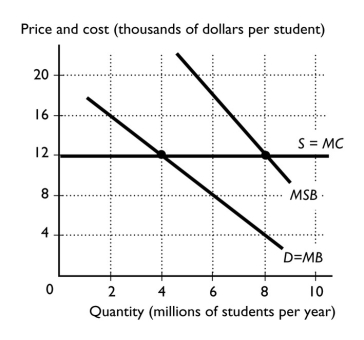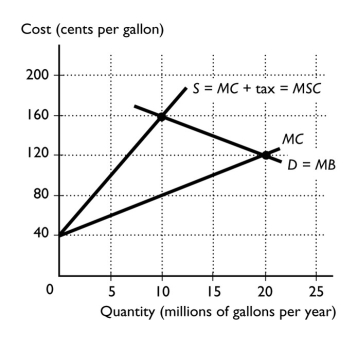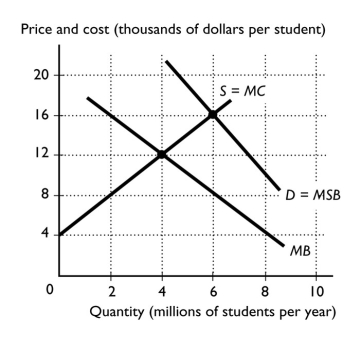A) $205,000
B) $105,000
C) $100,000
D) $5,000
F) A) and D)
Correct Answer

verified
Correct Answer
verified
Multiple Choice
Food stamps provided by the government to households are an example of
A) vouchers.
B) marginal benefits from producing a good or service.
C) marginal cost from producing a good or service.
D) marginal external cost.
E) a government good.
G) B) and E)
Correct Answer

verified
Correct Answer
verified
Multiple Choice
 -The figure above shows the market for annual influenza immunizations the United States. If the government intervenes in the market and provides a subsidy to providers of immunizations to immunize the efficient number of people, the amount of the subsidy is ________ per person.
-The figure above shows the market for annual influenza immunizations the United States. If the government intervenes in the market and provides a subsidy to providers of immunizations to immunize the efficient number of people, the amount of the subsidy is ________ per person.
A) $25
B) $50
C) $35
D) $15
E) $40
G) B) and E)
Correct Answer

verified
Correct Answer
verified
Multiple Choice
 -The figure shows the market for college education. If the market for education is competitive and with no government intervention, the equilibrium quantity of college students is ________ million and the efficient quantity of college students is ________ million.
-The figure shows the market for college education. If the market for education is competitive and with no government intervention, the equilibrium quantity of college students is ________ million and the efficient quantity of college students is ________ million.
A) 2; 4
B) 8; 2
C) 8; 4
D) 4; 8
E) 0; 10
G) All of the above
Correct Answer

verified
Correct Answer
verified
Multiple Choice
Which of the following is a method used by government to cope with the situation in which production of a good creates an external benefit?
A) removing property rights
B) subsidizing production
C) marketable permits
D) running a lottery
E) imposing Coasian taxes
G) A) and C)
Correct Answer

verified
Correct Answer
verified
Multiple Choice
When the production of a good has a marginal external cost, which of the following occurs in an unregulated market? I. Overproduction relative to the efficient level will occur. Ii. The market price is less than the marginal social cost at the equilibrium quantity. Iii. A deadweight loss occurs.
A) i only
B) ii only
C) iii only
D) i and ii
E) i, ii, and iii
G) None of the above
Correct Answer

verified
Correct Answer
verified
Multiple Choice
If a government action is designed to achieve efficiency, then the action must have the market produce the amount of output so that the
A) marginal private cost equals the marginal private benefit.
B) marginal social cost equals the marginal social benefit.
C) marginal external cost equals the marginal external benefit.
D) marginal private cost equals the tax.
E) marginal social benefit exceeds the marginal social cost by as much as possible.
G) A) and C)
Correct Answer

verified
Correct Answer
verified
Multiple Choice
 -The figure above shows the costs and benefits associated with producing paper. What is the efficient level of output?
-The figure above shows the costs and benefits associated with producing paper. What is the efficient level of output?
A) 0
B) 4 tons
C) 6 tons
D) More than 6 tons
E) None of the above answers is correct.
G) D) and E)
Correct Answer

verified
Correct Answer
verified
Multiple Choice
 -The figure above shows the market for annual influenza immunizations the United States. If there is NO external benefit from health care and the government does not intervene in the market, then the equilibrium price of immunizations is
-The figure above shows the market for annual influenza immunizations the United States. If there is NO external benefit from health care and the government does not intervene in the market, then the equilibrium price of immunizations is
A) $30.
B) $20.
C) $40.
D) $60.
E) $70.
G) B) and C)
Correct Answer

verified
Correct Answer
verified
Multiple Choice
 -The figure above illustrates the gasoline market. There is no external benefit from gasoline. If a tax on gasoline is imposed as shown in the figure, then the total tax revenue earned by the government equals
-The figure above illustrates the gasoline market. There is no external benefit from gasoline. If a tax on gasoline is imposed as shown in the figure, then the total tax revenue earned by the government equals
A) $24 million.
B) $16 million.
C) $8 million.
D) more than $24 million.
E) less than $8 million.
G) B) and D)
Correct Answer

verified
Correct Answer
verified
Multiple Choice
Cap-and-trade refers to
A) capping emissions and issuing tradable emissions permits.
B) capping revenue from selling emissions permits.
C) countries trading fishing rights in international waters.
D) capping taxes on firms that engage in international trade.
E) capping the benefits gained from pollution controls.
G) A) and D)
Correct Answer

verified
Correct Answer
verified
Multiple Choice
The benefit the consumer of a good or service receives is the
A) social benefit.
B) external benefit.
C) private benefit.
D) public benefit.
E) consumption benefit.
G) A) and B)
Correct Answer

verified
Correct Answer
verified
Multiple Choice
If there is no external cost, then marginal social cost
A) increases as output increases.
B) decreases as output increases.
C) is constant regardless of the level of output.
D) is unrelated to output levels.
E) first increases and then decreases as output increases.
G) B) and C)
Correct Answer

verified
Correct Answer
verified
Multiple Choice
 -The figure shows the market for college education. In order for the efficient amount of education to occur, the government could provide a subsidy of ________ per student.
-The figure shows the market for college education. In order for the efficient amount of education to occur, the government could provide a subsidy of ________ per student.
A) $4,000
B) $8,000
C) $12,000
D) $20,000
E) $16,000
G) A) and E)
Correct Answer

verified
Correct Answer
verified
Multiple Choice
 -The figure above shows an education market in which the government is providing households with vouchers. What is the efficient quantity of students?
-The figure above shows an education market in which the government is providing households with vouchers. What is the efficient quantity of students?
A) 2 million
B) 4 million
C) 6 million
D) more than 6 million
E) more than 4 million and less than 6 million
G) A) and B)
Correct Answer

verified
Correct Answer
verified
Multiple Choice
Private subsidies granted to producers affect
A) the supply side of the market by shifting the supply curve.
B) the demand side of the market by shifting the demand curve.
C) property rights.
D) transaction costs.
E) both the supply side of the market and the demand side because they shift both the supply curve and the demand curve.
G) A) and C)
Correct Answer

verified
Correct Answer
verified
Multiple Choice
Marginal private cost
A) is always zero if there is an external cost.
B) equals the marginal social cost only if the marginal external cost is positive.
C) is the cost of producing an additional unit of a good or service that is paid by the producer of that good or service.
D) the cost of producing an additional unit of a good or service that falls on people other than the producer of that good or service.
E) the cost of producing an additional unit of a good or service that is paid by the entire society.
G) D) and E)
Correct Answer

verified
Correct Answer
verified
Multiple Choice
Which of the following is an example of a product that is made available through public provision? I. local police protection Ii. public schools Iii. local fire department
A) i only
B) i and ii
C) iii only
D) i and iii
E) i, ii, and iii
G) A) and E)
Correct Answer

verified
Correct Answer
verified
Multiple Choice
External benefits are the extra
A) benefits a consumer gets from consuming a good.
B) costs a producer creates in producing a good.
C) benefits that accrue to people other than the consumers.
D) costs a producer bears for producing a polluting good.
E) benefits a producer obtains for reducing production of a polluting good.
G) B) and D)
Correct Answer

verified
Correct Answer
verified
Multiple Choice
Evidence of external costs in the production of a product is present if
A) the price of the product is higher than it should be.
B) the production cost increases because of an increase in the minimum wage.
C) non-buyers and/or non-producers of the product experience a loss for which they are not compensated.
D) buyers refuse to purchase the product.
E) producers pay all of the costs of producing the good or service.
G) C) and E)
Correct Answer

verified
Correct Answer
verified
Showing 261 - 280 of 290
Related Exams